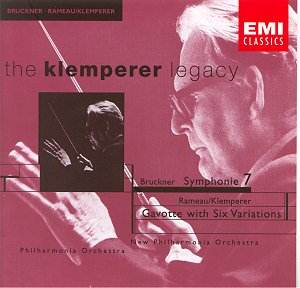BRUCKNER: Symphony No.7
Rameau: Gavotte with Six
Variations
 Philharmonia and New Philharmonia
Orchestras Conducted by Otto
Klemperer
Philharmonia and New Philharmonia
Orchestras Conducted by Otto
Klemperer
 EMI "The Klemperer Legacy"
CDM5 67330 2
EMI "The Klemperer Legacy"
CDM5 67330 2

Otto Klemperer recorded all the Bruckner symphonies for EMI from the Fourth
onwards. This Seventh comes from 1960 when the Philharmonia were in their
heyday and Walter Legge still in the control room, and it joins EMI's important
"Klemperer Edition". Klemperer's Bruckner style was always the most
"architectural" of his colleagues, with a remarkable feeling of separate
architectonic "plates" welded together within the music, each one stationary
against each other and yet, by some feat of concentration by conductor and
orchestra, pulling in opposite directions like "continental shift" threatening
earthquakes. Not to everyone's taste, of course. Too detached emotionally
for those who look to Bruckner for spiritual solace and human warmth. But
neither is the opposite pole, best represented by Furtwangler, universally
liked where no joins are apparent and the interpretation is imposed from
moment to moment in organic growth where bar lines seem to disappear. It
may be the case that an approach somewhere between these is what would suit
a newcomer, but Klemperer's recording is what concerns us here.
What you get is a very direct, unadorned treatment of the great arching theme
that opens the first movement but one that has the impression of being born
along by its own weight rather than any imposed from without. This brings
dividends in that the contrasting passages counterbalance, accentuating
Bruckner's impression of having built his musical edifice "stone by stone".
At the close of the movement the lasting impression is satisfying rather
than moving but, most important of all, the sense of an unbroken line
through the movement is palpable.
The great Adagio second movement can sometimes sound pious when played too
slowly with too great a stress on beauty of tone. But piety is the
last attribute you would ascribe to Klemperer. As with the first movement,
his grip on structure, and his unwillingness to linger over passing details,
brings a dignified and satisfying interpretation. The second subject is perfectly
judged, as also is the long coda that Bruckner wrote following news of Wagner's
death. The edition of the score used is the one by Leopold Nowak, which means
that Klemperer has the option of including the spurious cymbal crash at the
climax. He takes it, along with the full panoply of timpani and triangle
Nowak also allows for. This is not the place to go into the rights and wrongs
of this much-discussed "percussion event". For myself I believe the earlier
editor, Robert Haas, was correct in his edition in scoring no percussion
at the climax, but Klemperer is at least honest to the Nowak score in that
he gives us the full treatment making it sound part of the texture. Overall,
Klemperer sees this as quite muscular music which benefits from his customary
plain sound palette with woodwinds more forward than is often the case. The
original recording balance assists this and the remastering has been done
with care. There is a slight "fizz" on the brass full out, but this sound
is still representative of the kind being given to Klemperer at this time.
Note also Klemperer's customary dividing of his first and second violins
left and right which always offers insights.
The first two movements suit Klemperer's style well but the remaining two
much less so. The scherzo disappoints in being rather charmless, though it
has to be said anything else would not have been in the spirit of this kind
of performance. Likewise in the last movement Klemperer offers no easy options,
even though he succeeds in bringing out some of the mixture of good humour
and festive grandeur contained here. In the end I do believe there's more
to this music which a little more flexibility would have shown. However,
Klemperer's grip of structure means Bruckner's weakness in finales is all
but forgotten and the honest, "four-square" way he delivers the various sections
is certainly cumulative.
Whilst, in the final analysis, it may be too short on personal involvement
I believe this recording offers a window into the characters of its creator
and interpreter. Just too sober in the end for my liking, but it's undeniably
an important statement of attitude to this composer.
The coupling of Klemperer's arrangement for orchestra of some harpsichord
music by Rameau comes from 1968 and reflects his Catholic tastes as well
as his generation's missionary zeal in bringing before the public music from
an era they might have ignored in a form they would find more acceptable.
Purists will find it anachronistic. I find lovely music making which is itself
now representative of an era now gone. It makes an interesting and enjoyable
extra item on the disc.
Reviewer
Tony Duggan
Sound:

Performance:

